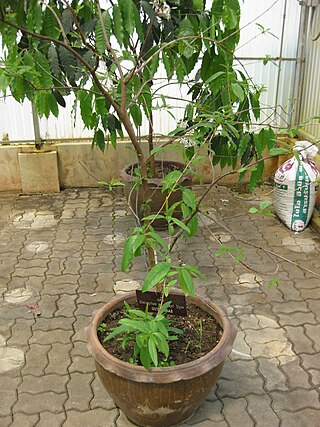
Mesua ferrea, the Ceylon ironwood, or cobra saffron, is a species in the family Calophyllaceae native to the Indomalayan realm. This slow-growing tree is named after the heaviness and hardness of its timber. It is widely cultivated as an ornamental for its graceful shape, grayish-green foliage with a beautiful pink to red flush of drooping young leaves, and large, fragrant white flowers. It is the national tree of Sri Lanka, as well as the state tree of Mizoram and state flower of Tripura in India.

Eucalyptus cladocalyx, commonly known as sugar gum, is a species of eucalypt tree found in the Australian state of South Australia. It is found naturally in three distinct populations - in the Flinders Ranges, Eyre Peninsula and on Kangaroo Island.

Syncarpia glomulifera, commonly known as the turpentine tree, or yanderra, is a tree of the family Myrtaceae native to New South Wales and Queensland in Australia, which can reach 60 metres in height. It generally grows on heavier soils. The cream flowers appear in spring and are fused into compound flowerheads.

Cratoxylum maingayi is a plant in the family Hypericaceae. It is named for the botanist Alexander Carroll Maingay.

Anisoptera costata is an endangered species of plant in the family Dipterocarpaceae. The specific epithet costata means "ribbed", referring to the prominent venation of the leaf blade. A huge emergent tree up to 65 m high, it is found in evergreen and semi-evergreen lowland tropical seasonal forests of Indo-Burma and in mixed dipterocarp forests of Malesia.

Mimusops elengi is a medium-sized evergreen tree found in tropical forests in South Asia, Southeast Asia and northern Australia. English common names include Spanish cherry, medlar, and bullet wood. Its timber is valuable, the fruit is edible, and it is used in traditional medicine. As the trees give thick shade and flowers emit fragrance, it is a prized collection of gardens.

Oroxylum indicum is a species of flowering plant of the monotypic genus Oroxylum in the family Bignoniaceae. It is commonly called Indian trumpet tree, oroxylum, Indian trumpet flower, broken bones, scythe tree or tree of Damocles. It can reach a height of 18 metres (59 ft). Various segments of the tree are used in traditional medicine.
Zanha golungensis, commonly known as the smooth-fruited zanha, is a species of plant in the family Sapindaceae that is native to Africa. It is used locally for timber and herbal medicine.

Maesopsis eminii, the umbrella tree, is a species of tree in the family Rhamnaceae found in India and Africa. It is the only species in the genus Maesopsis. It is often grown as a plantation tree, and as a shade tree in coffee plantations and other crops. Birds and monkeys may disperse the seeds. Since this tree grows fast it is often used for regeneration of destroyed forest lands. Its timber is used for construction and firewood and its leaves for animal fodder.
Gonystylus forbesii is a tree in the family Thymelaeaceae.
Madhuca motleyana is a tree in the family Sapotaceae. It is named for engineer and naturalist James Motley, who lived and worked in Borneo in the 1850s.
Madhuca ochracea is a tree in the family Sapotaceae. The specific epithet ochracea means "yellowish brown", referring to the indumentum.
Payena acuminata is a tree in the family Sapotaceae. The specific epithet acuminata means "tapering to a narrow point", referring to the leaf apex.
Lithocarpus coopertus is a tree in the family Fagaceae. The specific epithet coopertus means 'covered over', referring to the acorn.
Lithocarpus encleisacarpus is a tree in the beech family Fagaceae. The specific epithet is from the Greek meaning "enclosed fruit", referring to the acorns and cupules. The cupule is not fused to the nut though and often becomes irregularly dehiscent. The degree to which the nut is enclosed by the cupule varies across its geographic range. Trees in Lithocarpus are commonly known as the stone oaks and differ from Quercus primarily because they produce insect-pollinated flowers.

Pajanelia, sometimes known in English as tender wild jack or pajanelia, in Malayalam as azhantha or pajneli, in Kannada as alangi and in Tamil as aranthal, is a monotypic genus of evergreen or briefly deciduous flowering tree in the family Bignoniaceae which contains a single species, Pajanelia longifolia.
Hopea tenuinervula is a tree in the family Dipterocarpaceae, native to Borneo. The specific epithet tenuinervula means 'slender nerve', referring to the leaf veins.
Kokoona littoralis is a tree in the family Celastraceae. The specific epithet littoralis means 'of the seashore'.
Kokoona ovatolanceolata is a tree in the family Celastraceae. The specific epithet ovatolanceolata means 'egg-shaped tapering to the ends', referring to the shape of the leaves.
Kokoona reflexa is a tree in the family Celastraceae. The specific epithet reflexa means 'recurved', referring to the tip of the leaf.








